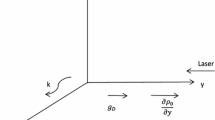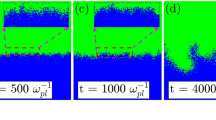Abstract
The laser ablative Rayleigh–Taylor instability plays an important role in the ignition of inertial refinement fusion. An accurate simulation of this process is important to control the growth of flow instability during the implosion. In this paper, taking the simulations of the hydrodynamics, the laser energy deposition and the electronic thermal conductivity into consideration, a massively parallel laser ablative Rayleigh–Taylor instability code based on Euler method is developed. Some open source codes are used to improve the code development efficiency. The accuracy of the hydrodynamics simulation is tested by an analytical theory about the weakly nonlinear Rayleigh–Taylor instability with double interfaces. The benchmark of an one dimensional heat conductivity is used to test the accuracy of the thermal conductivity simulation. The laser ablative plane target and the laser ablative Rayleigh–Taylor instability are used to test the reliability of the code on the simulation of the whole laser ablative process. It is shown that the confidence of our numerical simulation code is high and the code framework we designed is effective. It can be a basis on studying the problems about the laser ablative instability in inertial refinement fusion.











Similar content being viewed by others
References
Huntington, C.M., Shimony, A., Trantham, M., et al.: Ablative stabilization of Rayleigh–Taylor instabilities resulting from a laser-driven radiative shock. Phys. Plasmas 25, 052118 (2018)
Zhang, H., Betti, R., Gopalaswamy, V., et al.: Nonlinear excitation of the ablative Rayleigh–Taylor instability for all wave numbers. Phys. Rev. E 97, 011203 (2018)
Fan, Z., Luo, J.: Non-linear characteristics of Rayleigh–Taylor instable perturbations. Acta Mech. Sin. 24, 143–149 (2008)
Zhang, H., Betti, R., Yan, R., et al.: Self-similar multimode bubble-front evolution of the ablative Rayleigh–Taylor instability in two and three dimensions. Phys. Rev. Lett. 121, 185002 (2018)
He, X.T., Zhang, W.Y.: Inertial fusion research in China. Eur Phys. J. D 44, 227–231 (2007)
Wang, L.F., Ye, W.H., He, X.T., Wu, J.F., et al.: Theoretical and simulation research of hydrodynamic instabilities in inertial-confinement fusion implosions. Sci. China Phys. Mech. Astron. 60, 055201 (2017)
Wang, L.F., Ye, W.H., He, X.T., et al.: Preheating ablation effects on the Rayleigh–Taylor instability in the weakly nonlinear regime. Phys. Plasmas 17, 122706 (2010)
Lugomer, S.: Laser-generated Richtmyer–Meshkov and Rayleigh–Taylor instabilities in a semiconfined configuration: bubble dynamics in the central region of the Gaussian spot. Phys. Scripta 94, 015001 (2018)
Zhou, Y.: Rayleigh–Taylor and Richtmyer–Meshkov instability induced flow, turbulence, and mixing. Phys. Rep. 723, 1–160 (2017)
Ye, W.H., He, X.T., Zhang, W.Y., Yu, M.Y.: Effect of preheating on the nonlinear evolution of the ablative Rayleigh–Taylor instability. Europhys. Lett. 96, 35002 (2011)
Dahlburg, J.P., Gardner, J.H.: The effect of shape in the three-dimensional ablative Rayleigh–Taylor instability. \({\rm I}\): single-mode perturbations. Phys. Fluids B 5, 571–584 (1993)
Dahlburg, J.P., Fyfe, D.E., Gardner, J.H., et al.: Three-dimensional multimode simulations of the ablative Rayleigh–Taylor instability. Phys. Plasmas 2, 2453–2459 (1995)
Gittings, M., Weaver, R., Clover, M., et al.: The RAGE radiation-hydrodynamic code. Computat. Sci. Discov. 1, 015005 (2008)
Marinak, M.M., Kerbel, G.D., Gentile, N.A., et al.: Three-dimensional HYDRA simulations of National Ignition Facility targets. Phys. Plasmas 8(5), 2275–2280 (2001)
Fryxell, B., Olson, K., Ricker, P., et al.: An adaptive mesh hydrodynamics code for modeling astrophysical thermonuclear flashes. Astrophys. J. Suppl. Ser. 131(1), 273 (2000)
Woo, K.M., Betti, R., Shvarts, D., et al.: Effects of residual kinetic energy on yield degradation and ion temperature asymmetries in inertial confinement fusion implosions. Phys. Plasmas 25, 052704 (2018)
Zhou, Z., Ding, J., Zhai, Z.: Mode coupling in converging Richtmyer–Meshkov instability of dual-mode interface. Acta Mech. Sin. (2019). https://doi.org/10.1007/s10409-019-00917-3
Tian, B., Fu, D., Ma, Y.: Numerical investigation of Richtmyer–Meshkov instability driven by cylindrical shocks. Acta Mech. Sin. 22, 9–16 (2006)
Morpheus: https://sourceforge.net/p/morpheushydro (2014)
Falgout, R.D., Jones, J.E., Yang, U.M.: Numerical Solution of Partial Differential Equations on Parallel Computers, pp. 267–294. Springer, Berlin (2006)
Chang, T.Q.: Laser-plasma Interaction and Laser Fusion. Hunan Science and Technology Press, Changsha (1991) (in Chinese)
Spitzer, L., Harm, R.: Transport phenomena in a completely ionized gas. Phys. Rev. 89, 977 (1953)
Leer, B.V.: Towards the ultimate conservative difference scheme. V. A second-order sequel to Godunov’s method. J. Comput. Phys. 32(1), 101–136 (1979)
Einfeldt, B.: On Godunov-type methods for gas dynamics. SIAM J. Numer. Anal. 25(2), 294–318 (1988)
Wang, L.F., Guo, H.Y., Wu, J.F., Ye, W.H., et al.: Weakly nonlinear Rayleigh–Taylor instability of a finite-thickness fluid layer. Phys. Plasmas 21, 122710 (2014)
Atzeni, S., Meyer-ter-Vehn, J.: The Physics of Inertial Fusion: Beam Plasma Interaction, Hydrodynamics, Hot Dense Matter. Oxford University Press, Oxford (2004)
Roe, P.L.: Characteristic-based schemes for the Euler equations. Ann. Rev. Fluid Mech. 18, 337–365 (1986)
Toro, E.: Riemann Solvers and Numerical Methods for Fluid Dynamics. Springer, Berlin (1997)
Acknowledgements
This work was supported by the National Natural Science Foundation of China (Grants 11575033, 11675026, and 11975053) and CAEP Foundation (Grant CX2019033).
Author information
Authors and Affiliations
Corresponding author
Rights and permissions
About this article
Cite this article
Li, Z., Wang, L., Wu, J. et al. Numerical study on the laser ablative Rayleigh–Taylor instability. Acta Mech. Sin. 36, 789–796 (2020). https://doi.org/10.1007/s10409-020-00933-8
Received:
Revised:
Accepted:
Published:
Issue Date:
DOI: https://doi.org/10.1007/s10409-020-00933-8




